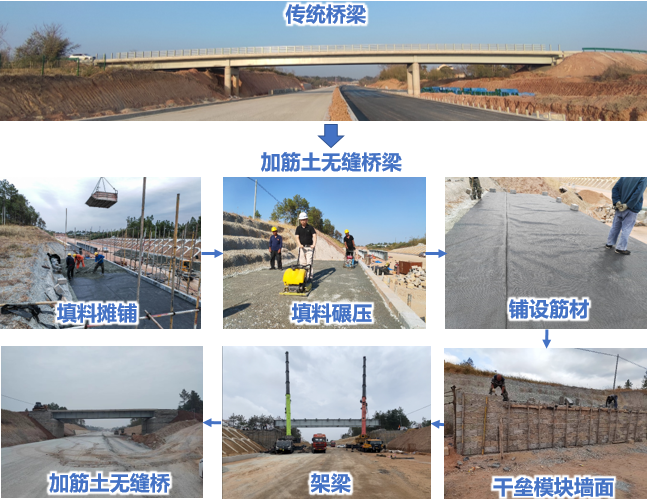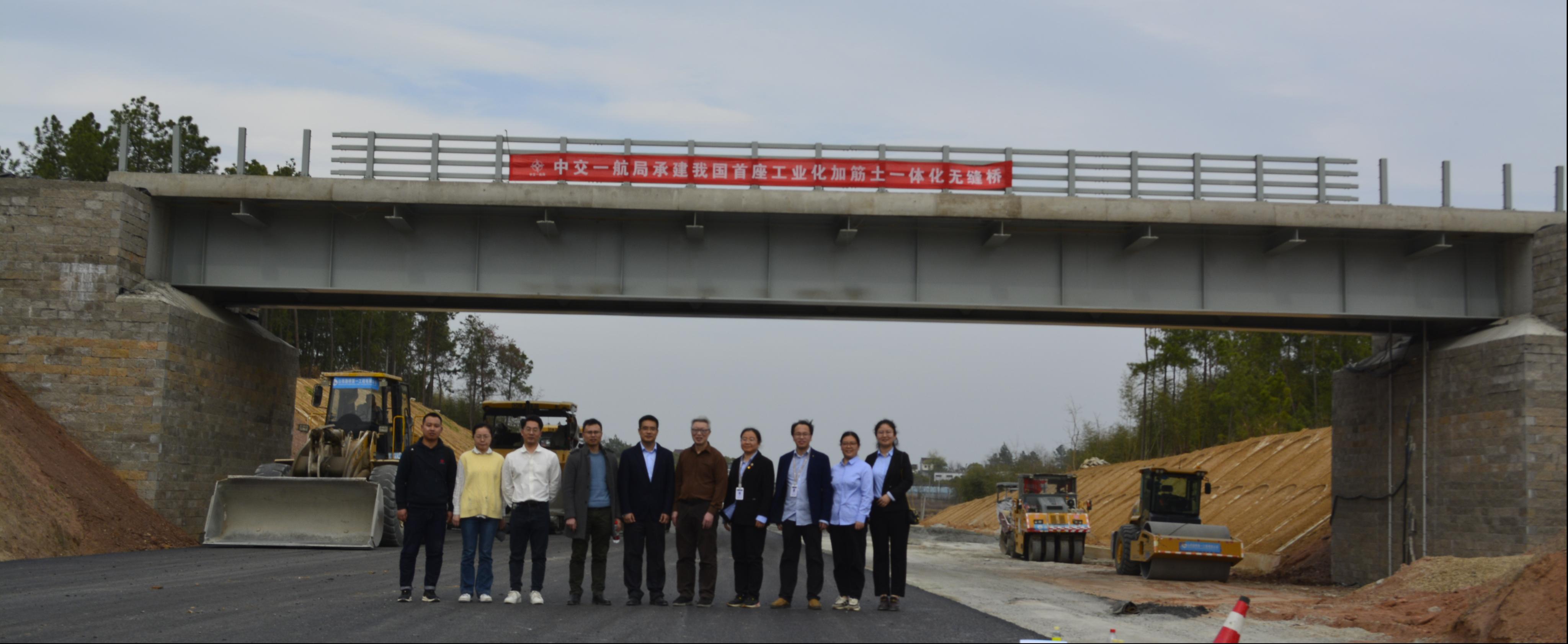The Anhui Wuyue Expressway is a model green road demonstration project at the ministerial level in the new era. "Key Technology Research on Geosynthetic Reinforced Soil-Integrated Bridge System" is a scientific research demonstration project for this project. The industrialized geosynthetic reinforced soil-integrated bridge already constructed serves as an experimental project for this research. In accordance with the requirements of the Ministry of Transport for green road demonstration projects, the design of the bridge abutment structure must possess the following characteristics: (1) low-carbon and emissions reduction, recyclable, and sustainable development. The geosynthetic reinforced soil(GRS)-integrated bridge uses physical reinforcement technology for roadbed filling to replace traditional reinforced concrete bridge abutments. Carbon emissions are reduced by more than 40%, and there is no chemical reaction during construction. In the future, expansion and reconstruction can be directly dismantled, reused, and rebuilt. In addition, it has excellent seismic performance; (2) rapid construction. The main reinforcement spacing of the bridge abutment is 20cm, and PP spunbond nonwoven geotextile is layered and compacted for filling. The construction is fast, and the construction equipment is simple. The main method is hand-held vibration plate compaction, and the single construction cycle is 12 days; (3) improved engineering quality. This type of bridge abutment eliminates the expansion device, minimizes the number of bridge maintenance and repair, and improves driving comfort; (4) economic savings. By using reinforced earth to replace reinforced concrete for the lower part of the structure, the experimental project directly saves construction costs of 565,000 yuan, accounting for 26% of the total cost of the bridge.
The GRS bridge is a vehicular overpass on the Wuyue Expressway. The design load is highway Class II, with a constant load of 163 kPa and a total load of 289 kPa. The seismic peak acceleration coefficient is 0.1 g. The bridge deck width is 8.5m and it is a single-span 34.4m steel plate composite beam structure. The GRS bridge abutment heights under the bridge span structure are 6.6m and 6.1m respectively. The height of the GRS road section connecting to the bridge span structure is 2.86m, as shown in the bridge layout diagram. Since the bridge span structure and the GRS road section connection are placed on the same GRS bridge abutment, differential settlement is avoided. Furthermore, the GRS abutment made of reinforced soil moves together with the bridge span structure due to temperature expansion and contraction, fundamentally solving the problem of bridge end jumping, and eliminating the need for expansion joints, resulting in a completely seamless bridge.
The original design of the bridge consisted of three spans with expansion joints. A comparison of the costs between the GRS bridge and the jointed bridge revealed that the GRS bridge eliminated the need for 136 meters of pile foundation (with a diameter of 1.4 meters, including pier caps) and 24.4 meters of bridge piers (with a diameter of 1.2 meters, including cap beams), reduced the area of the steel plate composite beam structure by 430.1 m2 (50.6 meters × 8.5 meters), and increased the volume of fill material by 1270 m3 (G-A-5 grade with crushed stone), 10075 m2 of geotextile, and 5278 pieces of dry-pressed simulated stone blocks. As the test project had a small volume, the construction cost of the jointless bridge was only reduced by 26% (approximately 565,000 yuan) compared to the original design of the jointed bridge. With large-scale application, the construction cost will be further reduced significantly. After completion, it will greatly reduce the maintenance and repair costs in the later stage, eliminate the traffic congestion or even interruption caused by the maintenance and replacement of expansion joints and bearings, improve the safety of the bridge and traffic, and the social and economic benefits of the full service life of the bridge are extremely significant.
The construction of the GRS bridge was carried out by Anhui Transportation Holding Group Co., Ltd., with design provided by Anhui Transport Consulting & Design Institute Co., Ltd., and construction by China Communications First Navigation Engineering Bureau Co., Ltd., and supervision by Anhui Highway Engineering Construction Supervision Co., Ltd. Anhui Transport Consulting & Design Institute Co., Ltd. and Tongji University formed a joint team to conduct scientific research projects based on this bridge. The bridge was completed on December 29, 2022. Over the past three months of performance monitoring, the measured settlement value of the GRS bridge abutment was 9.9mm, and the overall settlement strain was 0.15% (the design allowable value was 1%). Among them, the base settlement was 4.1mm, the compression of the GRS bridge abutment was 5.8mm, and the compression strain of the GRS bridge abutment was 0.09%. The compression of the GRS road connection section was 1.5mm, and the strain was 0.06%. The measured horizontal deformation value of the GRS bridge abutment was 6.1mm (the design allowable value was 52mm), and the horizontal strain was 0.23% (the design allowable value was 2%). The GRS road connection section and the bridge span structure were always closely attached, demonstrating excellent performance during service.

(a) Bridge layout diagram

(b) Construction


(c) photos of the completed bridge